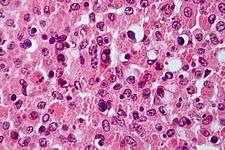Malakoplakia
| Malakoplakia | |
|---|---|
 | |
| Micrograph showing the characteristic finding of malakoplakia (Michaelis–Gutmann bodies). H&E stain. | |
| Classification and external resources | |
| DiseasesDB | 29128 |
| eMedicine | derm/872 |
| MeSH | D008287 |
| Orphanet | 556 |
Malakoplakia or malacoplakia (from Greek Malako "soft" + Plako "plaque") is a rare inflammatory condition which makes its presence known as a papule, plaque or ulceration that usually affects the genitourinary tract.[1]:274 However, it may also be associated with other bodily organs. It was initially described in the early 20th century as soft yellowish plaques found on the mucosa of the urinary bladder. Microscopically it is characterized by the presence of foamy histiocytes with basophilic inclusions called Michaelis–Gutmann bodies.
It usually involves gram negative bacteria.[2]
Causes
Malakoplakia is thought to result from the insufficient killing of bacteria by macrophages. Therefore, the partially digested bacteria accumulate in macrophages and leads to a deposition of iron and calcium. The impairment of bactericidal activity manifests itself as the formation of an ulcer, plaque or papule.
Malakoplakia is associated with patients with a history of immunosuppression due to lymphoma, diabetes mellitus, renal transplantation, or because of long-term therapy with systemic corticosteroids.
Treatment
Today, antibiotics are used for treatment of malakoplakia.
See also
References
- ↑ James, William D.; Berger, Timothy G.; et al. (2006). Andrews' Diseases of the Skin: clinical Dermatology. Saunders Elsevier. ISBN 0-7216-2921-0.
- ↑ Liang Cheng; David G. Bostwick (2006). Essentials of anatomic pathology. Springer. pp. 1180–. ISBN 978-1-58829-461-6. Retrieved 15 May 2010.